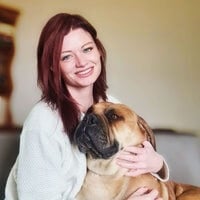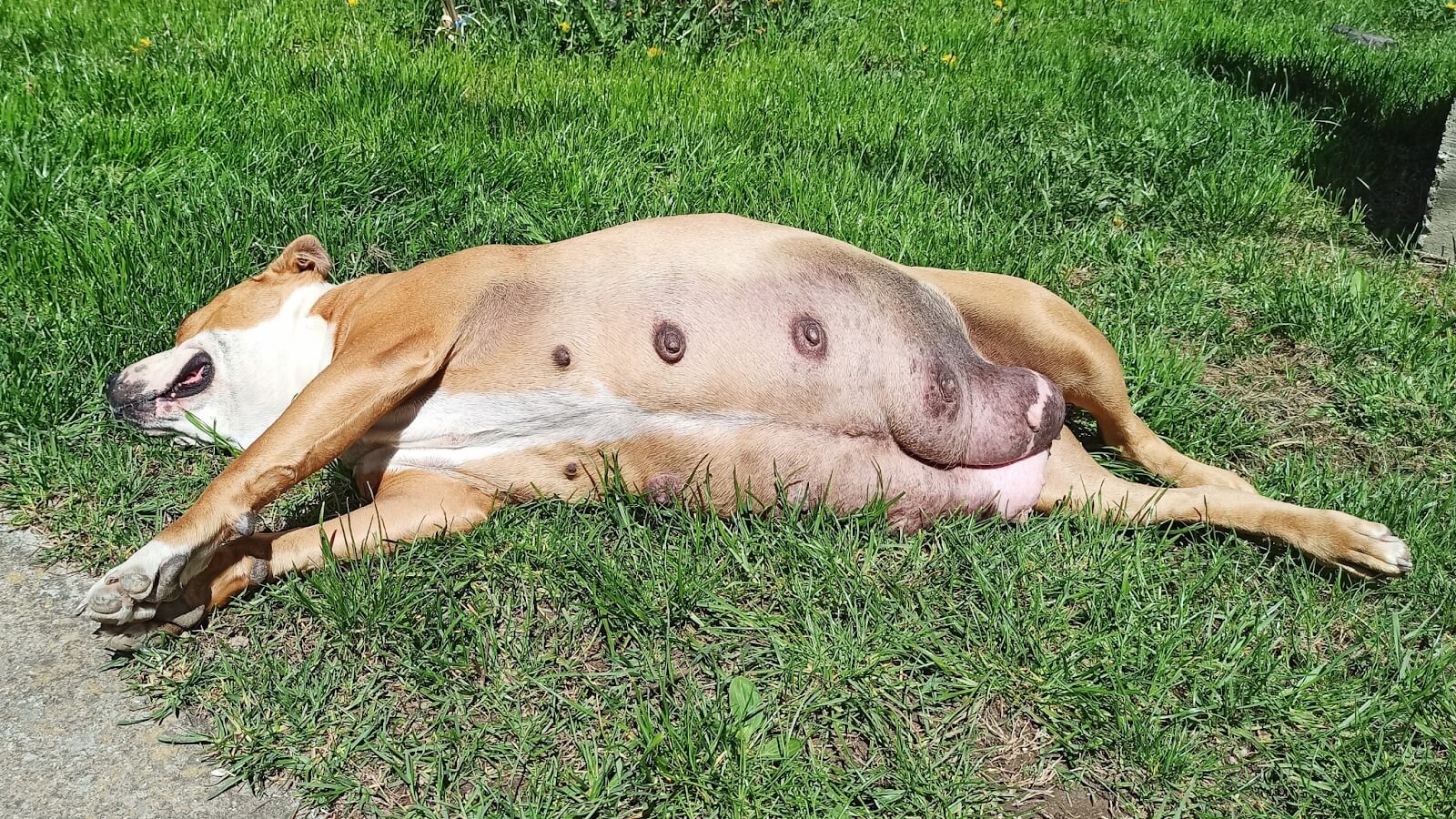There’s no shortage of ingrown hair videos on the internet, but what about ingrown hairs on dogs? Ingrown hairs or impacted hair follicles are common in dogs, and many pet parents take joy in prising them out with tweezers.
They certainly look uncomfortable if we see them on our dog paw pads or elbow calluses. So the temptation to lean on DIY home treatments is strong. But are ingrown hairs really a problem for dogs, and if so, what should we do about them?
What Are Impacted or Ingrown Hairs on Dogs?
An impacted hair follicle or ingrown hair on a dog is when the hair shaft gets stuck in the hair follicle and can’t grow out of the skin’s dermal layer. This usually happens when a dog’s hair is plucked, shaved, chafed, or damaged.
This is one reason it’s vital to use gentle dog shampoos and conditioners that don’t damage the dog’s coat or risk hair loss.
You may see ingrown hairs after a dog is shaved for surgery or, more often, along rough, callused areas where a dog’s skin chafes. These are usually along the sides of the paw pads or on pressure points like elbow calluses. If you squeeze these spots where the hair shafts are impacted (don’t!), you’ll see the hairs come out, like in this video:
Read this article if you are wondering how long it takes hair to grow back after it is shaved.
But, there is a lot of confusion on ingrown and impacted hair follicles in dogs, so let’s clear that up first.
Are Ingrown Hairs the Same as Folliculitis? Skin Problems that can be Confused with Ingrown Hairs
Regarding dog dermatology, they can have all sorts of similar-looking issues. This can be confusing, so let’s clarify a few terms.
- An ingrown hair is when the hair shaft gets stuck in the hair follicle. It can cause inflammation and infection so that it looks like a pimple or folliculitis, or it can look like a clogged pore or blackhead. In fact, the medical term for ingrown hair is pseudofolliculitis, implying it is a lot like folliculitis but not quite.
- If a dog has excess keratin and sebum in their skin from problems like seborrhea, they may get blackheads (comedones). These are clogged pores, but it does not mean the hair is clogging the pore.
- It is called folliculitis if a hair follicle becomes inflamed and infected, usually from bacterial skin infections related to pyoderma. If an infected or inflamed hair follicle erupts, it becomes furunculosis.
- If a dog has a pustule or inflamed bump, particularly around their muzzle, this may be dog acne.
A number of other skin conditions can also look like ingrown hairs or overlap with ingrown hairs. For instance, since ingrown hairs on dogs usually happen between the toes, you will often see it acral lick pyoderma, where dogs lick their paws so much they get infections. So keep an eye on dogs who lick their paws a lot.
But one of the key symptoms of acral lick pyoderma is folliculitis since the bacteria or yeast between the paw pads infects the hair follicles. And this is why diagnosing ingrown hairs on dogs can all get very confusing.
What Do Impacted Hair Follicles Look Like?
The most common ingrown hairs on dogs will be on the rough edges of the paw pads or on areas that chafe away the hair. This could be the armpits, pressure points calluses that form on the elbows, or other bony areas that push on hard ground.
They also happen between the toes, but if your dog has issues here, look out for one of the many infections that affect the canine toes.
At these points, the skin is often discolored. It may be black or grey from calluses or reddish brown. Typically, if you look closely, you can see the tips of the impacted hairs.
They usually look like the tip of a paint brush because dog hair actually has 3 to 15 secondary hairs that surround the big main hair. If the main hair is chafed away, you can see compound hair follicles poking out.
Sometimes a dog can get a bump that may look like a pimple or small lump anywhere on their body. This could be one single ingrown hair, as you can see in this video with a Golden Retriever:
In these cases, the main hair and its secondary keeps growing in the hair follicle, causing a small furry bird’s nest under the skin. Other signs of ingrown hairs are:
- Red and inflamed lumps and bumps;
- Pustules that look like pimples;
- Crusty or calloused areas that still have hair follicles; and
- Spots that look like blackheads between the toes or other areas where skin may chafe away.
Which Dogs Are at Risk of Ingrown Hairs?
Dogs with very short, harsh single coats are most likely to struggle with ingrown hairs. This includes most Pit-Bull type breeds, Bullmastiffs, French & English Bull Dogs, English Bull Terriers, Dalmatians, and Chinese Shar Pei.
The reason is that their hard, bristly hairs are easily forced backward when a dog walks, causing both ingrown hairs and infected hair follicles (folliculitis) in the toe webbing or other areas that chafe.
It is also very common in large and giant breeds that often develop calluses from lying on hard ground. These include any kind of Mastiff, Newfoundlands, and Great Danes.
Can You Pop an Ingrown Hair on a Dog?
It may be tempting to pop an ingrown hair on a dog. However, remember that ingrown hairs start because they are damaged, and plucking them usually means the hair will just get stuck again. Furthermore, a dog’s skin is more vulnerable to secondary infections than humans.
We can invite bacteria and yeast by popping ingrown hairs, causing new infections.
How Do You Treat Ingrown Hairs on a Dog?
Moisturize the Area
Keeping the area from growing too rough stops problems like excess keratin, which prevent the hair from growing naturally. It also keeps the area from cracking and causing an infection that would also damage the hair follicles.
Soak the Area
By softening the area this way consistently, you give the hair a chance to push through the skin and grow naturally outward. If you pluck the ingrown hair out, you make it more probable to reoccur. Softening the skin gives the hair a chance to find its exit from the follicle naturally.
Always moisturize the area properly after.
Avoid Shaving Your Dog’s Coat
Prevent Calluses and Chafing
Another point is to be careful of calluses and chafing. Large dogs like to lie on cold hard ground when they are hot, so it does not always help to put down blankets. Instead, experiment with light bandages on their pressure points.
Applying skin balms to the areas, including armpits, should prevent chafing during walks.
Also, make sure your dog’s harness fits. A badly fitting harness will most certainly cause coat problems.
Veterinary Treatment
If your vet decides to remove the hair, they can do it in a sterile environment and prescribe any medication your dog may need. They can also diagnose and treat any secondary or underlying problems your dog may have.
Final Thoughts
Dogs often get ingrown and impacted hairs. This is usually not a problem unless an infection arises. If you suspect an infection, especially in sensitive areas such as the toe pads, see your vet as they need specific antibiotics or antifungal treatments.
It can be tempting to remove the hair yourself, but rather don’t. A dog’s alkaline skin means they are always more vulnerable to secondary infections. If a dog is not bothered by ingrown areas, leave them alone. Instead, you can treat problem areas like the pad and calluses.








